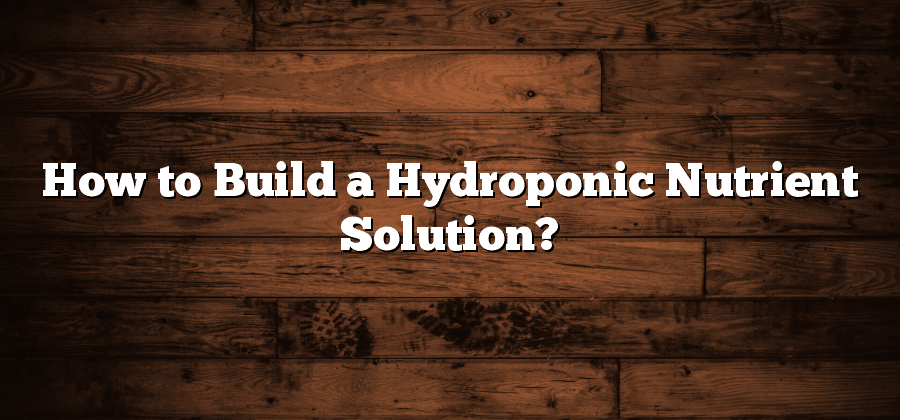Essential Nutrients for Plant Growth
Essential nutrients play a crucial role in the growth and development of plants. These nutrients are necessary for various plant processes, such as photosynthesis, cell division, and nutrient transport. While plants require multiple nutrients for optimal growth, there are three primary essential nutrients: nitrogen, phosphorus, and potassium.
Nitrogen is essential for plant growth as it is a key component of amino acids and proteins. It plays a vital role in the formation of chlorophyll, the pigment responsible for photosynthesis. Phosphorus is involved in energy transfer, cell division, and the formation of DNA and RNA. It promotes root development and flowering in plants. Potassium, on the other hand, is necessary for osmoregulation and enzyme activation. It enhances the overall health and vigor of plants, making them more resistant to diseases and stress.
In addition to these primary nutrients, plants also require secondary nutrients such as calcium, magnesium, and sulfur, as well as micronutrients like iron, manganese, zinc, and copper. These nutrients, although required in smaller amounts, are equally essential for different physiological and metabolic processes in plants. Overall, providing plants with the right balance of essential nutrients is vital for their growth, productivity, and overall well-being.
Understanding Macro and Micro Nutrients
Macro and micro nutrients play a crucial role in the healthy growth and development of plants. Macro nutrients, also known as primary nutrients, are those that plants require in large quantities to thrive. These essential elements include nitrogen, phosphorus, and potassium (NPK), which are responsible for stimulating root growth, promoting flower and fruit production, and enhancing overall plant vigor. On the other hand, micro nutrients are needed in smaller quantities but are equally important for proper plant functioning. These include elements like iron, manganese, zinc, and copper, among others. While their need may be less pronounced, the lack of micro nutrients can lead to deficiencies and subsequent stunted growth in plants.
Understanding the distinction between macro and micro nutrients is essential for gardeners and farmers alike, as it helps in identifying and addressing nutrient deficiencies effectively. Macro nutrients are usually prominent in commercial fertilizers and are readily available to plants. However, it is equally important to supply plants with an adequate amount of micro nutrients, as they are often lacking in natural soil compositions. It is crucial to strike a balance between all essential nutrients to ensure optimal health and growth of plants while preventing any nutrient imbalances that can hinder their development. By providing plants with the right blend of macro and micro nutrients, gardeners can ensure healthy and prolific yields, whether in their backyard garden or on a larger scale in agricultural fields.
Selecting the Right Nutrients for Your Plants
When it comes to selecting the right nutrients for your plants, there are a few key factors to consider. One of the most important considerations is the specific needs of each plant species. Different plants have different nutrient requirements, so it’s crucial to understand the specific macro and micro nutrients that are essential for their growth. Macro nutrients such as nitrogen, phosphorus, and potassium are needed in larger quantities, while micro nutrients like iron, copper, and zinc are needed in smaller amounts but are equally important for overall plant health. By understanding the specific nutrient needs of your plants, you can make informed decisions about which fertilizers or nutrient solutions to use.
In addition to considering the specific nutrient needs of your plants, it’s also important to consider the form in which these nutrients are available. Nutrients can be found in various forms, such as liquid solutions, granulated powders, or slow-release pellets. Each form has its advantages and disadvantages, depending on factors such as the plants’ growth stage, the type of growing medium used, and the desired rate of nutrient absorption. It’s essential to read the product labels carefully and choose a nutrient form that aligns with the requirements of your plants and your preferred cultivation methods. Investing time in understanding and selecting the right nutrients for your plants will contribute significantly to their overall health and productivity.
Balancing pH Levels in the Nutrient Solution
Maintaining the proper pH levels in your nutrient solution is crucial for the overall health and growth of your plants. pH, which stands for “potential of hydrogen,” refers to the acidity or alkalinity of a substance. In the context of hydroponics or soil-less gardening, pH plays a vital role in nutrient availability to the plants.
When the pH levels are not within the optimal range, the plants are unable to uptake the necessary nutrients efficiently. This leads to nutrient deficiencies or toxicities, manifesting as stunted growth, yellowing leaves, or even plant death. Therefore, it is essential to balance the pH levels in the nutrient solution to ensure that your plants receive the required nutrients in the right proportion. Monitoring and adjusting the pH of your nutrient solution regularly will help create an optimal growing environment for your plants, promoting healthy growth and abundant yields.
The Importance of EC (Electrical Conductivity) Levels
EC, or electrical conductivity, is a crucial factor to consider when it comes to maintaining optimal nutrient levels for your plants. Electrical conductivity refers to the ability of a substance, such as a nutrient solution, to conduct an electrical current. In the context of plant growth, EC levels provide insight into the concentration of essential nutrients in the solution, helping growers to ensure that their plants receive the appropriate amount of nutrition.
By monitoring and adjusting EC levels, growers can achieve a fine balance in nutrient concentration, allowing plants to thrive and reach their maximum growth potential. High EC levels indicate an excessive concentration of nutrients, which can lead to nutrient imbalances and subsequent plant stress. On the other hand, low EC levels suggest insufficient nutrient supply, resulting in stunted growth and nutrient deficiencies in plants. Therefore, maintaining appropriate EC levels is essential for promoting healthy plant growth and optimal nutrient uptake.






